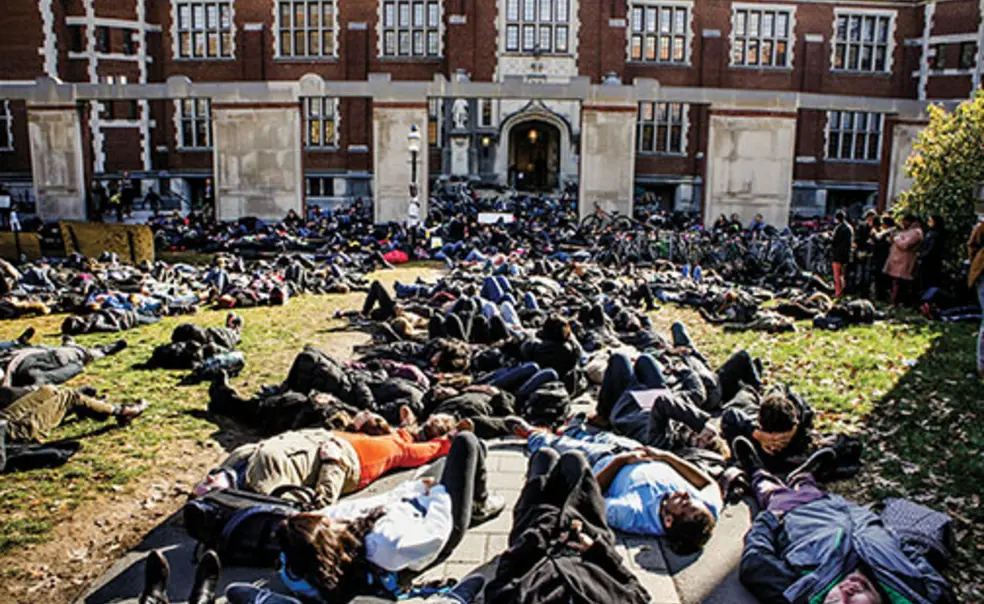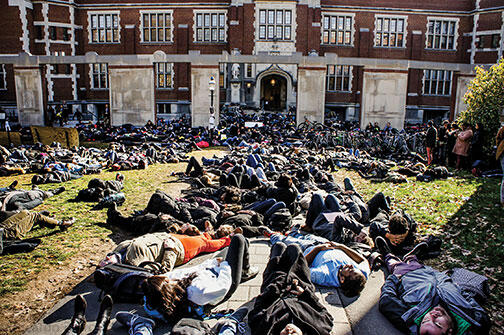Concerns About Race
As students protest racial inequality, University to review ‘inclusion’ policies
In the wake of student protests following the decisions not to indict police officers in the deaths of unarmed black men in New York and Ferguson, Mo., President Eisgruber ’83 announced a new effort to strengthen the University’s policies and practices “regarding diversity, inclusion, and equity on campus.”
At a Dec. 8 meeting of the Council of the Princeton University Community (CPUC), Eisgruber asked the CPUC’s executive committee to recommend ways to enhance the University’s policies and to provide opportunities to discuss national events. “Princeton has a responsibility to bring its scholarship and teaching to bear on these urgent problems,” he said.
About 150 students attended the CPUC meeting, and during a 90-minute discussion, several pressed for quick action on diversity-related issues. “A lot of us have been having conversations since we set foot on this campus, and right now we are very upset — we’re angry, and we want action,” Achille Tenkiang ’17 said.
“We’re having this conversation because we know we can do better,” Eisgruber said. “The measures that we take that are going to make a difference are measures that are well thought-through and measures that have the support of the community behind them, and not just a set of people in this room ... a collective decision by the University to do things differently than it has done.”
The CPUC meeting took place a day after the Undergraduate Student Government called on the University to establish concentrations in African American studies and in Latino studies, hire more faculty members of diverse identities and backgrounds, and implement mandatory training in effective interaction with people of different cultures for all University employees.
Eisgruber said a training program would have to be voted in place by the faculty before it could be established as mandatory for professors, but that he and his cabinet already had decided to take part in such training. Asked about a concentration in African American studies, he said this would require faculty and trustee approval. When the Center for African American Studies was created, he said, it was envisioned that “there might well come a time when the center would make a proposal for either the creation of a concentration or a department or both.”
Students handed out fliers listing suggested changes to the University policies that the students said “promote a campus culture acceptant of racial animus and insensitivity.” Their recommendations focused on three areas: transparency, awareness, and support. The CPUC executive committee met later in the week and created working groups to address each of those broad areas, promising a “comprehensive report” by May 2015.
The actions came after two campus protests. Several hundred students walked out of classes Dec. 4 to take part in a “die-in” outside Frist Campus Center to protest the decision by a grand jury not to indict a New York police officer in the death of Eric Garner. A week earlier, students had held a late-night demonstration along Prospect Avenue to protest the decision of a grand jury in Ferguson, Mo., not to charge a police officer in the death of Michael Brown.













3 Responses
John B. Gargalli ’60
9 Years AgoProtesting Racial Injustice
Re “Concerns About Race” (On the Campus, Jan. 7): These students (about 4 percent of the undergraduate student body) should spend their time taking advantage of the vast educational resources of Princeton University that have been made available to them and not let their behavior show that they are victims of the mass media and press. Seek the truth through learning, not by protesting and lying down on the grass. What have they accomplished? How do their GPAs reflect their lying down on the grass?
John W. Minton Jr. ’50
9 Years AgoProtesting Racial Injustice
Re President Eisgruber ’83’s statement on racial injustice and campus diversity: It has taken Princeton a very long time to convince me that it no longer espouses a belief and value system that I can support. I see no meaningful purpose in continuing “to take up arms against this sea of my concerns.”
I find nothing in our founding documents regarding human equality (whatever that may be), but they do refer to the inalienable right to life, liberty, and the pursuit — not achievement — of happiness. Equality of opportunity should not equate to equality of result, although many in the early days of the republic campaigned most vigorously for just that. Even today there are those who prefer a system that rewards all equally, regardless of effort or performance.
The deaths of Michael Brown and Eric Garner were the direct result of the actions of all the parties involved. The tragedy is in the inability of some parties to present an accurate and factual account of the events in question: to present all of the information regarding the deaths of these two individuals and then let all who care to reach his or her own conclusions.
Forced diversity, as well as results that are “directed from on high,” benefit neither the giver nor the given. The right to fail is every bit as important as the right to succeed.
Elizabeth M. Ramey *13
9 Years AgoProtesting Racial Injustice
Frankly, critics have missed the point of this protest and the broader social movement currently underway. We say all lives matter, but in reality, our society values some lives more than others. I am extremely proud of these students for living out the motto “in the nation’s service.”